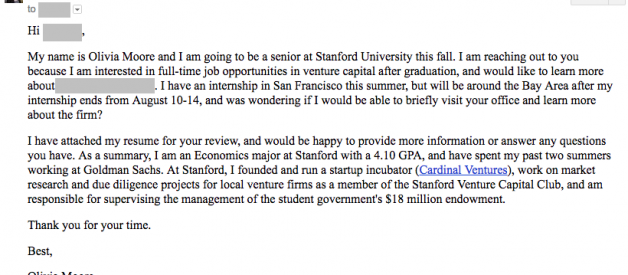This week, we?re covering something we?ve seen many students struggle with? how to write a good cold email. Conventional wisdom is to avoid cold emails, but we?ve found them to be very successful when done thoughtfully.
We?ve used cold emails to recruit speakers and mentors for the startup incubator we founded at Stanford, Cardinal Ventures, and Olivia got an internship with First Round Capital by cold emailing a Stanford alum.
 Olivia?s outreach to venture firms is fairly cringe-worthy and generic in retrospect (see tips below for how to avoid this), but did result in her getting an internship.
Olivia?s outreach to venture firms is fairly cringe-worthy and generic in retrospect (see tips below for how to avoid this), but did result in her getting an internship.
However, our experience pales in comparison to the cold email master, Jason Chen, who works with us at CRV. During his time at Princeton, Jason sent a whopping 485 cold emails, 350 of which resulted in interviews or calls. He also secured an internship with Anthos Capital from a cold email, and made many friends and personal connections that he?s still in contact with.
Jason?s advice is focused on using cold emails to get VC or banking internships, but is applicable across industries ? we?re excited to share his tips with you below!
How do you decide who to email?
I looked for firms that had hired analysts or interns before, because they were most likely to have an opportunity for me. I spent a lot of time researching the stage and industries that the firm invested in to make sure that the team?s focus was a fit with my interests.
For specific people, I focused on Princeton alums, and would recommend reaching out to alumni of your school ? they always want to help students. Try to find someone you have a second-degree connection with (LinkedIn is very helpful), so you can reference the person you have in common.
Did you focus on junior or senior investment professionals?
I contacted people at every level, from analysts to GPs or MDs. You can?t be afraid of emailing more senior people ? a lot of them have been in your position, and they appreciate seeing someone who is willing to hustle.
What did you include in the email?
I would first introduce myself and explain how I got the person?s contact info or any mutual connections we had. Then I would discuss my interest in a space that the person was looking at, a portfolio company, or a recent investment that he or she made, mentioning any relevant experience I had. Finally, I would conclude with an ask for that person ? typically to hop on a call or meet up to discuss opportunities with his or her firm.
Editor?s note: We?d also recommend including a PDF of your resume, if you are reaching out specifically about a job!
 One of the 485 cold emails Jason sent over his college career.
One of the 485 cold emails Jason sent over his college career.
Would you send a follow-up if you didn?t get a response?
Many people would respond to my initial email in 1?2 days. If I didn?t hear back in a week, I sent a follow up, reiterating my interest and asking for time to talk. Follow ups are important because some people use them to gauge how interested you are in talking to them and how much you are willing to hustle. If they didn?t respond to my second email, I?d take it as a ?no?.
How did you keep track of all of these emails?
I created an Excel spreadsheet to track my interactions. I had columns for the each person?s name, company, position, email address, and general areas of interest. I also kept track of when I reached out to the person, whether or not they replied, and if I needed to respond or follow up, and eventually built out a CRM based on this.
How did you find email addresses?
I used the Rapportive plug-in. You can also check the person?s LinkedIn and the firm?s website. I also sometimes used email testers, guessing the format (e.g. [email protected]?) based on other email addresses I found.
Speaking of tools, I used the free version of Bananatag to track my emails. It let me keep track of who was opening my messages, which was helpful.
What?s the best time to send a cold email?
I found the most success by sending emails early in the morning or right before lunch ? people tend to read and respond to emails at those times. The afternoon (2?5pm) is not good, because people are typically busy and not keeping up with their email. Earlier in the week is always better. I would recommend sending emails on Monday or Tuesday, if possible.
Overall, would you say your cold email strategy was worth the time?
Yes! I reached out to 485 people, and got 350 phone or in-person interviews. I became friends with ~50 people, and still catch up with 25 of them on a monthly basis. During my sophomore year, I got an internship with Anthos Capital through a cold email.
Even if your email doesn?t result in an internship offer, cold emails help you expand your network, practice your interview skills, and learn more about the industry. I found that the people I reached out to would often introduce me to others, which was extremely helpful. If you talk to enough people, you will eventually find something!
Huge thanks to Jason for taking the time to talk with us about his cold email strategy! We?d love your feedback on this post and other career questions we should cover? you can reach us at [email protected] and [email protected]. You can also subscribe to our weekly newsletter, Accelerated, for more tips on finding the perfect job or internship: https://accelerated.carrd.co/


